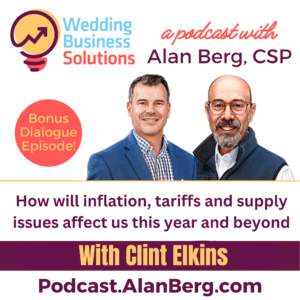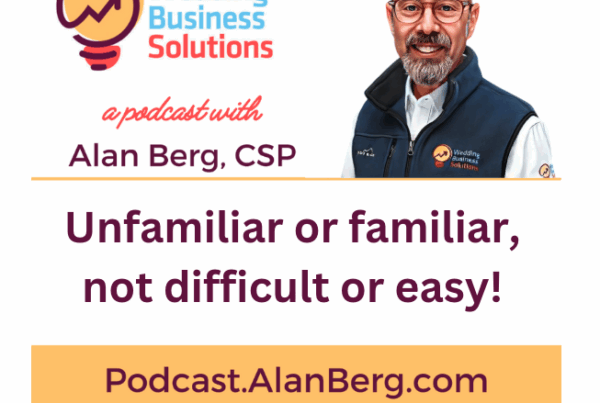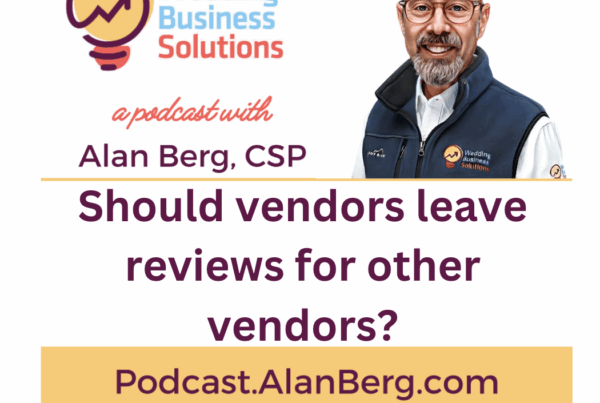 Clint Elkins – How will inflation, tariffs and supply issues affect us this year and beyond
Clint Elkins – How will inflation, tariffs and supply issues affect us this year and beyond
Are your rising costs really out of your control? Are tariffs, inflation, and supply chain chaos just the new normal, or are there ways to get ahead of them? In this episode, I bring on Clint Elkins to dig into what’s really happening with food costs, supply challenges, and the hidden factors that set your prices—plus how to spot trends before they hit your bottom line. You’ll hear how natural disasters, labor markets, and even global events ripple through catering and events, and learn fresh ways to adapt, save, and thrive even in volatile times.
Listen to this new episode for insights on controlling costs, navigating unpredictable markets, and strategies venues and caterers can use to stay profitable in a changing world.
About Clint:
As US Food’s largest client, SB Value has over 28k locations and $10 Billion in buying power to help caterers, concessionaires and culinary professionals get the best prices for their food and supplies.
- https://www.wegrowvalue.com/
- https://www.facebook.com/wegrowvalue
- https://www.instagram.com/wegrowvalue
Contact Clint: [email protected]
If you have any questions about anything in this, or any of my podcasts, or have a suggestion for a topic or guest, please reach out directly to me at [email protected] or visit my website Podcast.AlanBerg.com
Please be sure to subscribe to this podcast and leave a review (thanks, it really does make a difference). If you want to get notifications of new episodes and upcoming workshops and webinars, you can sign up at www.ConnectWithAlanBerg.com
View the full transcript on Alan’s site: https://alanberg.com/blog/
Okay, so tariffs and supply chain and inflation. What the heck’s going on these days? Well, listen to this episode and find out. Hey, it’s Alan Berg. Welcome back to another episode of the Wedding Business Solutions podcast. I am so happy to have my friend Clint Elkins on to talk about the craziness that’s going on in the market these days. So, Clint. What? Welcome, and thank you.
Oh, thank you for having me, Alan. I appreciate you reaching out to us, and I’m. I’m a big podcast fan, so I look forward to it.
Well, I. I appreciate you coming on because this is the kind of conversation you and I would normally have in the hallway at Cater Source or something like that. And I. I thought it’s important for everybody just to understand what’s going on because, you know, you hear always the worst stuff, right? You always hear the worst stuff online, on social media and on the news, things like that. So, you know, for background, just tell everybody real quick what it is that you do.
Yeah. So we are a. We. We’re a group purchasing organization or a gpo. We’re just a collaboration of businesses working together to negotiate pricing. We’re the largest food supplier in the country. We spend about $10 billion a year with US Foods. So we have economists on staff, we have chefs on staff, we have salespeople on staff.
So we have a really good pulse, probably a little better than anyone in the hospitality industry, to see what is currently going on, what future projections look like. So we’re a sales team with a little bit of knowledge that maybe we can help you a little bit.
That’s great. And I’ve referred a lot of my clients to you. I don’t have a lot of affiliates, and I’m very careful about them, but you’re saving a lot of my customers a lot of money. And that’s why I thought having you on here would certainly help here. So we have things going on from tariffs that are now coming at us from all different directions. And, you know, whenever this is released, I’m sure there was a tariff last week, there’ll be a different next week or whatever’s going on. And then you have crazy things like the price of eggs. Right.
All of a sudden, the price of eggs spikes. So let’s just start over there, right? Why did the price of eggs all of a sudden spike?
I mean, if you. If you look back historically, you know, you can pick out, it’ll be eggs this year to be pork, next year to be chicken. The year after that, whatever, you know. But the bird flu. The bird flu is, is what the cause of the. The egg spikes were, you know, and we’re all, we all see it in the grocery stores every day. You know, we all feel it. What alternatives are there? I can tell you that our economists, for future projections, you also, I mean, you look up the fda.
I mean, that stuff’s pretty easy to research, that everything looks really good for this year. You know, pork prices are going to be down a little bit. Poultry is going to be down a little bit. Beef is going to be a level maybe, maybe spike a little bit more toward the end of the year. Coffee’s pretty stable. And that’s usually a pretty good indicator as well. I mean, we’re all, we’re all affected by everything that happens. This is a big world, and we’re affected by what happens, you know, with weather and with flus and everything else.
But, you know, the last. Ever since COVID you know, we’ve seen just the huge spikes on everything. And now all that stuff is flattened out finally, and we are starting to see some reductions now. Do we think prices are going to come way down? That’s very doubtful. You know, just watch the housing markets anywhere you live. It’s very similar to that. You know, once those get up, it’s hard to get that stuff back down.
Right. So the bird flu is just supply and demand. The, the bird flu means that there are less eggs being produced that are safe. Therefore, supply and demand says the price can go up. We. We got lucky the other day. My, My son and his family came and they. So they brought us, you know, fresh eggs.
So there we go.
We’re safe on the price of eggs here in this household, at least for this week. Maybe. There we go. But, you know, pretty much everybody is affected when it comes to things like the, the political stuff with the tariffs, right. If you’re buying your, you know, wedding dresses from China, right, And there’s tariffs go on, they may go on that, they may not. If you’re buying your, your photo booths or your DJ equipment or your speakers, you know, where is it being manufactured? You know, the whole idea that, you know, the other country pays the tariff. No, countries don’t pay tariffs. Companies pay tariffs, and that’s just an expense.
And if their expenses go up, prices go up, right?
Yeah, it’s pretty simple. I mean, it’s funny we say this. There’s two examples. One I can give you is you and I were talking offline. We’re building a New home right now. And a lot of our lumber obviously comes from Canada. And our builders like don’t pay a whole lot of attention to it because time we get to that, it’ll change and then by the time we get to that stage, it’ll change again and then something else will change. He said, the best thing I can tell you is to cut your TV off.
Which I thought was brilliant, brilliant advice. Yeah. You know, because we’re all looking for clickbaits. We’re all looking for anything that’ll drive ratings, you know, so one of the really cool things, and I can tell you that just working with, with US Foods and obviously when you work with US Foods, you work with United States based food companies. So you know, they have features that you can search, you know, a 25 mile radius of your location to see what products are coming from where, you know. So if you’re, if your salmon’s coming from a river close to you or your eggs are coming from the farm from the next town over, terrorists don’t affect that stuff a whole lot, you know, so it’s like anything else. You can look at it and you can diagnose it as much as you want to. You know, I was reading a story this morning about diamonds.
You know, lab grown diamonds have lost like 70% of their value in the last year. So if someone’s bought an engagement ring and bought a lab grown diamond and all of a sudden their engagement’s off, they come back to the store, they bought it, it’s worth about 70% less than they paid for it last year just because of supply and demand. So it’s, it’s, it’s everything. It’s food, it’s groceries, it’s diamonds, it’s lumber. You know, this is a very volatile world we live in right now. And we’re so connected that we see everything that happens all the time, or at least the things maybe we want to see or don’t want to see. But it can get a little worrisome sometimes.
Yeah, well the other part of that, that ring story is that gold has gone up because some countries aren’t buying US treasuries, instead they’re buying gold. Well, if they are buying gold, that’s going to bring this price of gold up. So maybe they won’t get their money back on the lab grown diamond. Maybe they’ll get it back on the gold.
Good luck to you, right?
Exactly. But you know, about the lumber, we don’t pay a lot of attention to that because of us, Canada and Mexico being such easy trading partners historically and because of creating things like NAFTA or whatever, replace that, you know, you’re getting that lumber from Canada and it’s a seamless thing. You go to Home Depot, you go to Lowe’s, you go to your local lumberyard, there it is, right? It’s just there. And you’re, you’re probably not paying attention to where it came from, but you know, you need not just lumber. You need the right lumber to build your house. You want the right quality lumber to build your house. You don’t just want whatever’s available. It’s like, you know, me with, with whiskey, with barrels.
You know, you take for granted that this went into a barrel. There you go. Or it’s in a barrel. But there’s science behind who, where those trees grew on what side of what mountain and did the sun face this way or whatever. And you know how it can’t be have any knots because it’ll leak and all that. But we take that for granted, right? It’s just there, there is your whiskey in the bottle or whatever and you don’t, you don’t pay any attention to that. It’s when these things happen that there’s the ripple effect. You know, when there’s an energy crisis and gasoline prices go up, well, costs more to deliver the stuff to your store.
What are they going to do? They’re going to charge you more. That’s what it is. So, so in the big picture, looking forward, right, you can micro this and say, okay, right now eggs are up, they will come down when the supply comes back. But if there’s a pork scare, right, a pig scare or whatever, pork prices will go up. These are temporary things. Is that basically what we should be thinking?
Yeah. Now some of these things you can get pretty long. Like cattle herds are supposed to. Cattle herds have been trending down and that’s supposed to hit the bottom, you know, the rock bottom in early 26, I think it is. So, you know, the economists can forecast that stuff out. Hey, we, we kind of know when that’s coming. Now you take natural disasters, you take like again, I live in North Carolina, it’s pretty easy to tell. I’m from the South.
So we, several years ago, you know, we had huge hurricanes came through. And the pork, a ton of the pork in the United States comes from eastern North Carolina and eastern South Carolina. There are huge hog farms down through there. So the hurricanes killed a ton of hogs and the prices went up. You can’t really predict that stuff Right, but that’s. It happens. It’s a once in a lifetime thing, but it does happen. But our economists can look for the future and so does FDA and say, hey, you know, supply and demand, there’s plenty of pigs out there for all the pork we need.
So for 2025, if anything, these prices are going to come down a little bit. So unless there’s something weird that happens throughout the year, usually those year long projections are pretty close. You know, it could be, you know, coffee beans in Colombia, I think it was two years ago, there was a, maybe a freeze or whatever it was and affected all that and coffee got spiked. You can’t really see that. You know, maybe the, the Farmers Almanac can, I don’t know, you can’t really see that stuff, but for the most part it’s pretty accurate. So you shouldn’t. I would be surprised if there were any. Barring a natural disaster, I would be surprised there was any, any real fluctuation in what we’ve seen all year long.
And again, you know, go back to cater source, talking to a lot of the chefs and people down there that follow this stuff just as close closely as we do and maybe have different sources. Everybody was pretty much on the same page.
So let’s talk about prices from before COVID to now. Restaurant prices have gone up, fast food prices, things like that, and they seem to not be going back down. So what changed from then to now where things are back to air quotes, normal, whatever that means that, that those prices wouldn’t come back down. Right? What happened?
Well, so you know, we all know that the, the, the biggest indicator of pricing is, is energy, is fuel. So fuel goes up, everything goes up, right? Yeah, that’s, that’s the lifeblood of everything. During Covid’s a little weird because you couldn’t get people to work. That stuff’s still there, you know, where, where, where labor is always your number one source of, of cost. You know, with labor costs still being as high as they are. That’s why we are still seeing prices as high as they are. The biggest, the biggest reason. So you take inflate.
So inflation over the last year was. Food cost was about 17 and a half percent over last year. That was the national average.
Okay.
What we do, our national average was right at 5%.
Okay.
We follow. And again, not to give you an infomercial, but we follow the same graphs that anyone else does. But our stuff, the way our program works, it’s just more streamlined. So you cut some of that labor out there’s. Where the fluff is, is built in labor. And I mean, listen, people are what makes the world go around. And you’re only as good as the people that work around you. Don’t get me wrong.
But there still is a lot of smoke and mirrors built in on, on some things like that, you know, no difference than, you know, let’s go back to the housing market. If, if the housing market here in the Charlotte area now is twice what it was before COVID so you’re sitting on a house that’s worth half a million dollars now. It’s worth $1 million. Well, when the realtor sells it, their 3% is now twice as much as it was. You know, so that money is good because it’s going back into the economy. But those prices on that stuff, because the demand still there is not coming down. When people stop eating at places, at places that charge a lot, that’s the only effect there’s going to be on any of that stuff. It’s not just that it means it’s anything, it’s the clothes you wear.
Yeah, so. So let’s, let’s talk about something else again. I, I don’t want to talk politics specifically, but there are some effects here. You have a big push on illegal immigration and it’s a well known secret that a lot of what happens in the food service industry in terms of, from the, from the farm to the table is happening. And there are, you know, illegal immigrants that are doing that work. Right. They’re, they’re planting those crops, they’re picking those crops and putting them on trucks and doing stu like that. Have, what is there, what is the prediction, how that is going to affect that? That’s everybody now.
That’s not just caterers and venues and stuff like that. That’s us going to the grocery store. What’s the chatter about that and when do we think we might start to feel it or are we already feeling it?
I have no idea. The chatter on that is pretty tight lipped because I don’t think anyone really knows what that looks like. I can tell you this. So back before COVID we were working on a big project up in North Dakota and it was a farm that had 22,000 acres. And they had, it was soybeans, sunflower seeds and corn. That was a 22,000 acres.
Okay. So I grew up on a farm, you know. So as we’re doing this project, asked these guys, said, how big of a staff do you have? Was nine full time people and five of them were the Brothers that owned everything. They were on the front side of technology.
Yeah.
They didn’t need. Which is good or bad. It depends on how you look at it. They didn’t need big labors. But also too, the crops they’re farming are crops that you can use machinery and can use technology with.
Right.
So I don’t, I mean, I think anyone that’s not a politician probably couldn’t answer that completely accurately. You know, I know that in the conversations we have, that’s not. You don’t hear about it a whole lot.
Yeah.
Taboo or what? You just, you don’t hear about it.
Yeah. Nobody wants to get into that. Or as I say, we shouldn’t talk politics without alcohol in our hands. Right. That, that’s the best way to do it.
This is water.
There you go. Well, I have Diet Coke here. That’s my, that’s my brown, my daytime brown liquid. My nighttime one is whiskey. But I remember going to wineries and you would see the vineyards and some of the vines were just, you know, growing like they would normally grow. And other ones were growing in these just perfect rows and straight up and down because they were getting picked. Those grapes were getting picked by machine. But a lot of them can’t be because they’re on hillsides and things that these machines can operate on.
But the ones where they can plant them on flatter ground and they can do that stuff, if you’ve ever seen them taken, you know, the, what is it, the almonds and stuff off the trees where they literally just shake the tree until they, they, they fall down. But there’s somebody on the ground taking that stuff. You know, human, humans are still going to be involved. But yeah, technology, it’s never going to replace everybody. But there’s certainly the ability. But if you have a farm and you can’t afford those, you know, multimillion dollar pieces of equipment to go do that, there’s going to be a challenge. Right. Can’t, you can’t work with it.
Can’t work without it.
Yeah. I mean, and you brought up a great industry. I mean, look, look at the wine industry. It’s down 20 over last year. Yeah, you know, that’s, that’s. As a, as a someone that enjoys wine a lot, a whole lot. It, it’s, it’s surprising to me. But you start looking at the data and start looking at the analytics of why the wine industry is down so much, it makes a lot of sense.
Going back to what you and I talked about a minute ago, I think if you look Deep enough into anything, you can make sense of it. You know, just what, what matters to you, you know, where are you going to spend your time? You know, so like what we do when Covid was one of the best things that happened to our business because people realized real quick that it’s time to save money, they needed to spend more time saving money. I mean, I refinanced my house twice during COVID Yeah, me too. So, yeah, so I, I can’t say anything to, to potential clients I have about not reading the emails I send them or not following up with me when we meet somewhere because I was almost guilty of the same thing when I had one of those aha moments. I was like, wait a minute. Me refinancing my house is the same thing as us saving their money on everything they’re buying for their kitchens. So it put a, put a magnifying glass on a lot of that stuff and it opened up the world to people to say, hey, you know, just because I’ve done things just like this for a long time, you know, we don’t have to continue to do these kind of things.
Yeah, I have that. You know, my home insurance, my, my car insurance, stuff like that. Every once in a while you reevaluate that kind of stuff. The, the food and supplies for the, the caterers and for the venues that do catering is such a huge part of their expense. And like anything else, it feels like there’s a pain to switch. Right? Like switching my car insurance. Like if I want to apply for insurance, they’re going to check your credit these days. Well, my credit’s frozen so that nobody can open up an account in my name.
So I have to go to all three bureaus, unfreeze the credit, do that. There’s a pain. But the other side of it is if I’m saving money, I’m saving money this year and next year and the year after and, and doing stuff like that. So, you know, short term pain, long term gain. And I know the way you’re saving people money, whether it’s single digits and some of them double digits on their supplies, that’s, that’s a, that’s a quiet background savings, right? You’re like, once you make that switch, you don’t have to keep doing it or you have people. I’ve had some clients I’ve sent to you, they’re already using US food. So the same truck’s going to come and you’re just going to save money. But people are skeptical, you know, too good to Be true.
It’s one of those things that seems like it’s too good to be true, truthfully, but it’s not. It’s one of those things. All right, so we’ll put some links in later for the people that are interested. But so, so the prediction for inflation and things like that in the future, if you’re not, if you did turn off your tv, right. If you turned off your tv, you’re hearing that it’s going to be, you know, pretty smooth. You’ll have some little rocky stuff like the eggs. Right. But other than that, other than that.
Things should go down. If anything, things should be going down a little bit. Pork and poultry are both scheduled to go down a little bit, which is the first time and I think in seven years any of that’s happened. So if, if nothing else, they should stay pretty flat.
Right. So you might save at the supermarket on that, but your restaurant might not lower the price of your pork chop dinner.
Something like that.
Something like it. Well, I had, I had somebody during COVID Somebody put off their date and they, they rebooked the date, but now the price of the food had gone up. And the, the caterer came to me and said, could you help me word a message to them to let them know we’re going to be raising their price? And I said, okay, well, before we do that, does your contract allow that? And they went back and looked. They came back and said, no, it doesn’t. I said, okay, well, then there’s nothing to discuss here. What you need to do is change your contract going forward. But I asked them a question. I said, have you ever booked somebody and then by the time their event came, some of your prices had gone down? And they said, yes.
I said, and you lowered their price, right? And they said, well, no, we didn’t. I said, so now you want the other side of that, right? You made that extra money there. So, yeah, if you put it in your contract, that’s fine. But come on, you know, you can’t have it both ways on that. It’s got to be one or the other. So, you know, I mean, that care.
If, if a caterer could sell a cost plus program, you know, based on pricing to it to a couple to get married, that’s what you would do. Yeah, but I don’t think that’s the industry standard, you know, program.
No, no. You know, and again, while some of your prices gone up, maybe some of your prices went down and you know that it’s a cost of doing business because you’ve made money that way in the past. You’ll make money that way in the future, but you’re going to try to just charge more. And I think it’s tough. Right? Do you want to now show your costs
It’s, it’s very tough. And you know, when we, we. I speak on the panel at Cater Source every year and during COVID like that was, you know, coming at which, you know, we were at Cater Source during COVID when it hit.
Oh, yeah. Oh, yeah.
So the next year or two, it was all the contract talk. You know, so many people had really gotten the short end of the stick on contracts and, and they fulfilled their contracts and they, they, they did that and they, they took a hit on those things. They amended their contracts after that, you know, but now you don’t hear about stuff anymore. And unfortunately there’s, there’s going to be. We did it ourselves. You know, we’ve got binds on things like that ourselves. So we all live and learn, but, I mean, you can’t see what, you don’t know what’s coming.
Right, right. And, you know, all those things about the force majeure clauses in our contracts that nobody ever paid attention to, they’ve been there forever. And then all of a sudden you now had to enforce that and you’re like, what even is that? And now it’s not just, did you have it, what, how was it worded? And, and all this other kind of went along.
And there’s so many creative things too. You know, it’s like, you know, you’re going to have a, a summer wedding or a spring wedding, whatever it is, and you’re going to have, you know, whatever vegetables. Well, if asparagus is more than broccoli this week, that’s why you build in seasonal vegetables. You can, anything you want to, you know, just be creative with that stuff. And if nothing else, blame it on insurance, because insurance always gets the short ends of blame.
Well, if you’re in Florida trying to get insurance on your house or your high rise, then that’s certainly a thing there. I’ve done that with a lot of my clients. I look at their menus and I say, you know, why are you specifying the, you know, the side vegetable? It should just be seasonal vegetable and a fresh, fresh green salad and that maybe it’s kale, maybe it’s romaine, maybe it’s arugula, whatever. But it’s a fresh green salad. And that gives you the flexibility to, first of all, Friday, Saturday, Sunday, provide the same salad the same vegetable, easy to order, easy to prep, all that kind of stuff. But also years ago I had this. This is what got me started with that. I had a client, they’re at the market and the beo, the banquet event order said broccoli.
And the broccoli was good that day. But the asparagus was amazing. And in order to change it to asparagus, the chef would have had to call from the market to the customer and say, is it okay if I switch? Instead of making the decision that oh my gosh, this is amazing asparagus, let’s just do asparagus. You know, unless it was specified, don’t do asparagus. Right, Something like that. And that’s why giving yourself more flexibility. And then the craziest thing about weddings and events in general is one or two people choose a menu for everybody, right? They don’t know. All those people, they don’t know what they like to eat.
And at a wedding especially, the two people that choose the menu are the least likely people to eat at that event, Right. And you who are engaged, congratulations, you will find that out at your own wedding where you’re hardly eating anything, right? Well, hopefully you will. Hopefully you will there. But, but it’s just funny that you’re choosing this food for people you don’t know and then you don’t even end up eating yourself. Right? It’s crazy. So, all right, so if you are a caterer or a venue listening and you wanted to find out more and so Clint, just real quick again, not, not big infomercial here, but how does it work that you show somebody whether they can or can’t save with a GPO like yours?
Yeah, it’s super simple. We can do a price comparison right off the bat. It takes a day and we’ll do an Apples Apples comparison if you’re buying. You know, our program is built on we have 28,000 clients. So you know, Alan, if you had 28, 000 wedding venues, you would get better pricing than when you have. It is that simple. So we can work directly off the invoices you have. Send them to us.
If you take your prices off, you can. It doesn’t matter. Everything we do is pre negotiated. Go back to those spikes in the graphs we talked about, right? You’ll see real quick how much money you can save. And then we just set up an account for you with US Foods and you order your product from them. You’re now U.S. food’s largest customer. So you get the leverage of spending $10 billion a year.
You never pay us a dime for anything. You pay us foods, what they charge for food, and that’s it. It’s super simple. Our national savings average is about 17%. So in the catering industry, it’s about 15%. So if you’re spending $200,000 a year with your. With your supplier, we’ll save you $30,000 a year on average.
That’s great. So. So you have to be a caterer, not a restaurant. Right. Or unless. Unless it’s like a golf course that has a little, you know, cafe in there or something like that. 19th hole, something like that. All right, so we’ll put that in the show notes how people can get a hold of you.
You can do that. No charge to do that, that comparison. Right?
Free.
There you go. And so everybody listening. Things are kind of where they are, probably where they’re going to be. There’s always going to be spikes. We can’t predict something like a hurricane taking out pigs in North Carolina. Just can’t predict that stuff. Or what is it, an atmospheric river coming through California? Because whoever heard of that before? I don’t know.
I’ll think anybody. We can just make words up as we go these days.
Yeah, that’s what the weather people do to justify their. Justify themselves there, so. Well, Clint, thank you so much for joining me. Thanks for, for sharing your wisdom, sharing what you’ve heard out there and giving people maybe a little bit of peace of mind on this.
Alan, I appreciate you having us, and I’m happy to come back anytime if anybody wants to hear anything about, you know, anything I want to say, so you can check me out. WeGrowValue.com is our website, WeGrowValue.
Com. And just tell them you heard them on the podcast over here and maybe you’ll come back and talk about your wedding experience.
I’m happy to. It’ll be very easy. I can do that in 30 seconds.
All right, Bye. Bye.
Thank you.
I’m Alan Berg. Thanks for listening. If you have any questions about this or if you’d like to suggest other topics for “The Wedding Business Solutions Podcast” please let me know. My email is [email protected] or you can text, use the short form on this page, or call +1.732.422.6362, international 001 732 422 6362. I look forward to seeing you on the next episode. Thanks.
Listen to this and all episodes on Apple Podcast, YouTube or your favorite app/site:
- Apple Podcast: http://bit.ly/weddingbusinesssolutions
- YouTube: www.WeddingBusinessSolutionsPodcast.tv
- Spotify: https://spoti.fi/3sGsuB8
- Stitcher: http://bit.ly/wbsstitcher
- Google Podcast: http://bit.ly/wbsgoogle
- iHeart Radio: https://ihr.fm/31C9Mic
- Pandora: http://bit.ly/wbspandora
©2025 Wedding Business Solutions LLC & AlanBerg.com





